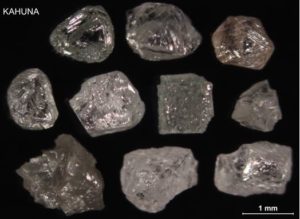Kahuna kimberlite sample yields 2.32 carats/tonne

Commercial-sized diamonds (+0.85 mm) recovered from the Kahuna kimberlite near Rankin Inlet, Nunavut. Source: Dunnedin Ventures Inc.

Dunnedin Ventures Inc. [DVI-TSXV] reported the its first diamond recovery results from the Kahuna kimberlite near Rankin Inlet, Nunavut, northern Canada. The 144.44-kg sample of Kahuna returned 13 commercial-sized stones (+0.85 mm) totalling 0.334 carats, for a sample grade of 2.32 carats/tonne. The largest recovered diamond was a 0.12 carat clear and colourless twinned octahedral stone. There were 87 diamonds recovered in total.
Chris Taylor, Dunnedin’s CEO, said, “The Kahuna kimberlite is a large target with a maiden Inferred Resource of over 3 million tonnes, and potential for an additional 3.7 to 10.7 million tonnes at a range of depths. Historical bulk sampling yielded 1.04 carats (+0.85 mm) per tonne, but audits to determine a final sample grade do not appear to have been completed by the past operator. With this latest sample returning 2.35 carats per tonne, the company is strongly encouraged by the size and grade potential of this kimberlite, and we view bulk sampling to determine diamond value as a priority.”
Most of the Kahuna diamonds recovered by Dunnedin are clear and colourless variants of octahedra. The Kahuna sample was treated through an autogenous mill-fusion circuit located at CF Mineral Research, Kelowna, British Columbia, using a lower size cut-off of 0.425 mm. Unlike standard DMS recovery methods, the circuit can recover nearly all diamonds present in a kimberlite sample to the predetermined cut-off size, along with associated indicator minerals.
About the Kahuna Kimberlite
- Near vertical high grade kimberlite dike that extends to surface with over 4.5 km of drill-defined strike length and remains open to extension along strike and at depth
- Defines the northernmost drilled portion of a 20+ km strike length kimberlite-intruded structure that also contains the Notch kimberlite dike; over 2,500 metres of historical drilling and 360 tonnes of historical bulk sampling have been completed at Kahuna
- Historical and current samples were taken at the same locations or within metres of each other
- Most historical drilling is within 80 to 120 metres of surface, however some deeper drill holes were completed and also intersected the kimberlite more than 200 m vertically from surface, indicating continuity to depth where tested
- Width reported as generally between 2 and 4 metres, with an average of 3.2 metres, and an average density of 1.99 t/m3
Dunnedin is now recovering diamonds and indicator minerals from a series of kimberlite and till samples collected during two field seasons. An inferred resource showed over 4 million carats of macrodiamonds (+0.85 mm) grading 1.01 carats/tonne had been defined along the partial strike length of the Kahuna and Notch kimberlite dikes through shallow drilling. The largest diamond recovered was a 5.43-carat stone from the Kahuna dike which was a piece of a larger diamond that had been broken during the sample preparation process and was reconstructed as having an original size of 13.42 carats.

I have diamonds rocks